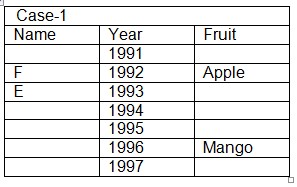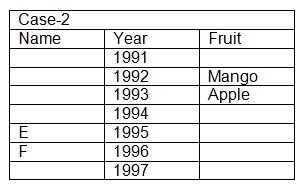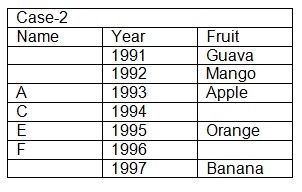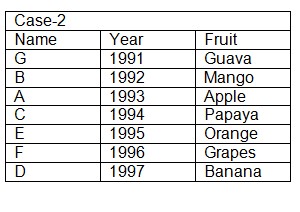Question
Who among the following person likes Papaya?
Study the following information carefully and answer the below questions. Seven person namely – A, B, C, D, E, F and G was born in different year from 1991 to 1997. All the calculations are done from current year 2019. Each person likes different fruits viz. Apple, Banana, Guava, Mango, Papaya, Grapes and Orange. All the information are not necessary in same order. Two person was born between the one who likes Mango and E. Three person was born between the one who likes Banana and A. Number of person elder to the one who likes Apple is half the number of person elder to E. F neither was born after the one who likes Banana nor likes Papaya. Number of person born before the one who likes Mango is same as number of person born after F. A neither likes Mango nor was born before the one who likes Guava. Two person was born between C and the one who likes Guava. At least two person was between the one who likes Papaya and G. C neither likes Banana nor was born after E. Number of persons born after the one who likes Mango is two more than number of persons born after C. D was born just after the one who likes Grapes.Solution
Number of person elder to the one who likes Apple is half the number of person elder to E. Two person was born between the one who likes Mango and E. That means, in case (1) the one who likes apple was born in 1992, in case (2) the one who likes Apple was born in 1993. Number of person born before the one who likes Mango is same as number of person born after F. F neither was born after the one who likes Banana nor likes Papaya. That means, in case (1) F was born in 1992, in case (2) F was born in 1996. Based on above given information we have: 
 Again, we have: Three person was born between the one who likes Banana and A. A neither likes Mango nor was born before the one who likes Guava. That means, in case (1) E likes Banana, in case (2) the one who likes Banana was born in 1997. C neither likes Banana nor was born after E. Two person was born between C and the one who likes Guava. That means, in case (1) C was born in 1991, in case (2) C was born in 1994. Number of persons born after the one who likes Mango is two more than number of persons born after C. That means, in case (2) E likes Orange, case (1) is not valid. Based on above given information we have:
Again, we have: Three person was born between the one who likes Banana and A. A neither likes Mango nor was born before the one who likes Guava. That means, in case (1) E likes Banana, in case (2) the one who likes Banana was born in 1997. C neither likes Banana nor was born after E. Two person was born between C and the one who likes Guava. That means, in case (1) C was born in 1991, in case (2) C was born in 1994. Number of persons born after the one who likes Mango is two more than number of persons born after C. That means, in case (2) E likes Orange, case (1) is not valid. Based on above given information we have:  Case (1) is not valid as the Number of persons born after the one who likes Mango is two more than number of persons born after C Again, we have: D was born just after the one who likes Grapes. That means, D was born in 1997. At least two person was between the one who likes Papaya and G. That means, G was born in 1991. Based on above given information we have final arrangement as follows:
Case (1) is not valid as the Number of persons born after the one who likes Mango is two more than number of persons born after C Again, we have: D was born just after the one who likes Grapes. That means, D was born in 1997. At least two person was between the one who likes Papaya and G. That means, G was born in 1991. Based on above given information we have final arrangement as follows: 
The Krishi-Decision Support System (Krishi-DSS) is primarily aimed at advancing which sector?
What is the primary goal of sustainable agriculture?
The National Agricultural Cooperative Marketing Federation of India Ltd (NAFED) is an apex organization of marketing cooperatives for agricultural prod...
Who broke Sachin Tendulkar's record to become the fastest to reach 26,000 international runs?
The central government has launched the “Mera Ration Mobile App” in the country on
Which of the following committee was involved in the recommendation of establishment of NABARD………………..
Who has authored the book “The Hero of Tiger Hill” ?
The birth anniversary of Vergese Kurien is remarked as National Milk day and is celebrated on
…………………………State Government has launched the trees outside forest in India programme in association with USAID.
...e- NAM was launched on ………… under the Ministry of Agriculture and Farmer’s welfare.
Relevant for Exams:


